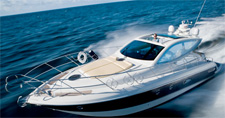
A wing engine is used for emergency propulsion and also efficient engine running at low speeds.
One possible issue with twin engine installation in a motor cruiser, is access for servicing. Depending on how deep the V bottomed hull is, it can be difficult to get to the outboard sides of the engines.
When an engine needs upgrading, rather than rebuilding the existing engine, and only if there is space, it is possible to build a wing engine. This will ensure that access to main engine is not compromised and there is access to the extra engine.
The wing engine will offer two benefits - an emergency means of propulsion, and a single engine working hard when slow speed is required. This is much better than running the main engine under very light load.
Adding the extra engine and fuel system to a heavy build means the fully laden displacement may cause the boat to exceed its specifications, and possibly compromise cruising speed. Engine choice has to be a compromise of cost, weight, size and power.
A 13hp motor will give around 4.5 knots in calm conditions and about 8 miles per gallon. Running the engine at 10hp will give around 4 knots and 10mpg. A 14hp Kubota-based engine, on a boat like this, should fit requirements and with a 40A alternator fitted will offer excellent battery charging while running under a reasonable load. Don’t forget, an alternator will offer little charge with the engine running at low rpm.
For a main engine with a capacity of 100gal, giving a potential range of over 200 miles at 10 knots, a wing engine should use a standard 10gal – giving a useful range of around 90 miles at 4 knots.
As part of fail-safe philosophy, the two fuel systems are not connected, each having its own filter. The two electrical systems are also completely independent. They could be interconnected using jump leads.
Its worth considering that a major part of this kind of project could be the calculation of the position of the engine beds to give the required angle for the shaft, and the length of shaft and the size and position of the P brackets.
Once the engine is set up, a hole is drilled through the hull and after checking the alignment, a full size hole must be bored for the stern tube, the shaft fitted and P brackets fitted. The tube is then glassed in place, the P bracket bolted through internal and external backing pads and the stern gland fitted. Once the propeller shaft is in pace, proper alignment should be carried out. And with the engines exhaust bend close to the waterline, a water separator should be fitted with a swan neck to ensure no cooling water can find its way back to the cylinders.
With all the hard work involved in fitting a wing engine, is it worth it? Fitting a wing engine gives the added benefit of single engine accessibility, economical low speed cruising when necessary and the luxury of a completely independent back-up population system.